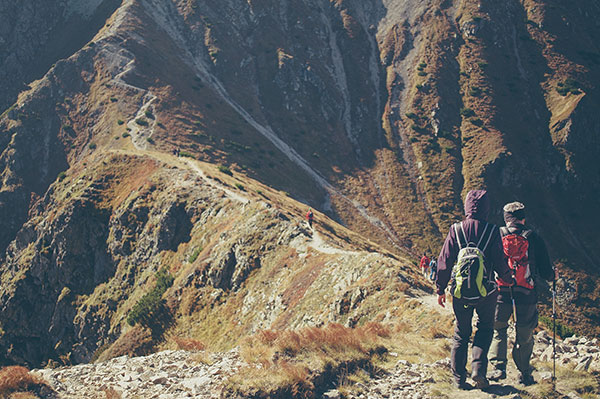Subtotal: $
Checkout
Most animals walk within a few hours of their birth. Humans, of course, do not. But unlike other faculties that develop over time, “walking is unusual as a learned skill,” writes Shane O’Mara. Language, for example, requires exposure. In contrast, even “feral children,” or those rescued from “restricted environments, will still generally walk upright” – walking as innate to the point of destiny.
O’Mara, a neuroscientist at Trinity College, Dublin, explains that “learning to walk is driven more by the unfolding of underlying motor programs, perhaps inherent in the design of the motor circuits of the spinal cord and the brain, than is the case with language.” In plain English, we are biologically, cognitively, perhaps even spiritually compelled to walk. O’Mara’s new book In Praise of Walking helps us understand why.
We walk as long as our legs allow it; we walk to get places, and for pleasure. Much of the book takes commonsense inclinations about the benefits of walking and turns them into scientific observations. Most people feel a little more alive after a walk in the woods, and O’Mara says “there is now an emerging body of science that supports this anecdotal feeling, and which indicates that walking, especially in regular doses, often in nature, does actually improve how we feel.”
Regular walking creates “plastic changes in the very structure of the brain, strengthening it in ways similar to how muscles are strengthened when worked.” Locomotion alone is not enough – cars, trains, buses don’t cut it – only natural motion will do. Feet on the pavement. Muscles at work.
Erwin Straus, one of O’Mara’s influences, brings a more confrontational interpretation: “Our upright posture is an indispensable condition of man’s self-preservation,” wrote Straus, a German psychiatrist and phenomenologist who taught at the experimental Black Mountain College in the mid-twentieth century. “Upright posture, which we learn through falling, remains threatened by falls throughout our lives.” Our natural stance, Straus argued, was “resistance.” We move to live.

Public domain
“The history of walking is an unwritten, secret history whose fragments can be found in a thousand unemphatic passages in books, as well as in songs, streets, and almost everyone’s adventures,” wrote Rebecca Solnit in her 2001 paean to walking, Wanderlust. Solnit’s book is expansive, clever, inspiring. The “rhythm of walking generates a kind of rhythm of thinking, and the passage through a landscape echoes or stimulates the passage through a series of thoughts.” She cites Henry David Thoreau as well as Jean-Jacques Rousseau and Søren Kierkegaard, who thought that we need to get moving in order to get thinking.
Following down this path tread before him, O’Mara calls on philosophical and literary figures including Thoreau, Rousseau, and Kierkegaard as well, supplying research to support their qualitative insights. “Walking’s essential and intrinsic virtues and rewards” are especially important to charging creative minds, O’Mara explains.
Essentially, our brains have two “work modes.” There’s an “active, executive mode,” which takes care of our focus, and how we process what we see and encounter. Then there’s what he calls the “default mode,” which is replete with “mind-wandering”: a form of cognitive meandering. Walking, as “a form of active idleness,” creates the perfect circumstances for creative thinking: “it is directed action and focused, but walking allows the mind to wander easily” – to go on an adventure within parallel to the adventure without.
T. S. Eliot’s “The Love Song of J. Alfred Prufrock,” for example, is “a journey on foot, and a journey through states of mind,” writes O’Mara, whose “opening lines are an invitation to walk the city”: “Let us go then, you and I,” the poetic narrator says, “Let us go, through certain half-deserted streets.” Here he might be expected to run into Solnit again, for whom urban walking is a way to chart cultural history at the level of the street, transgressively venturing out into “the melancholic, poetic, intoxicating carnival of city nights.”
O’Mara, for his part, prefers grass over asphalt: “When you hillwalk, you often follow paths that have been inscribed by millions of footfalls over very many generations.” In one intriguing aside that I wish were more fully developed, O’Mara stresses that “where we walk” can have profound results. Cloisters “allow people to walk outdoors while protected from the elements,” and “are sometimes referred to by their ritual and processional purpose – deambulatorium, obambulatorium, ambitus – the solemn, Latin descriptors of the architectural elements of a monastery, all derived from the root ‘ambio’ – ‘I walk in a circle.’”
There’s more to say about this. Although O’Mara doesn’t mention him, I can’t help but think about how important walking was to the Jesuit poet Gerard Manley Hopkins. The priest took frequent walks; often with friends, sometimes alone. During his journeys, he would stop to sketch: a great elm, a seemingly ancient tree stump, or even an apple tree, its “sprays against the sky arc gracefully curved and the leaves looping over edge them, as it looks, with rows of scales.” A walk through Hopkins’s journals reveals that he saw the world best while walking. We might want to follow in his footsteps.
Already a subscriber? Sign in
Try 3 months of unlimited access. Start your FREE TRIAL today. Cancel anytime.






